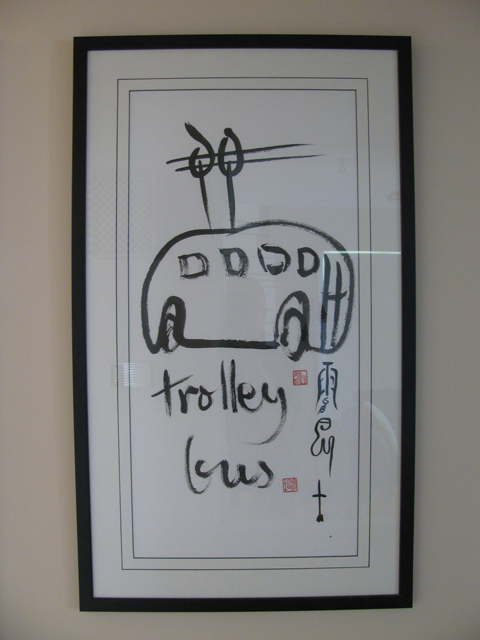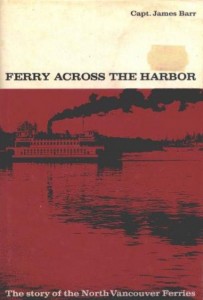Links and tidbits for Mon July 30, 2012
Links and tidbits for Mon July 30, 2012

Here’s our semi-regular roundup of interesting tidbits and links about transportation from the last week or so. If you have links to contribute, put them in the comments or email us!
- Buzzer pal Derek Cheung sends us a question: Can you help me identify the unknown artist (image above)? It was given to me by a retired trolley coach operator ten years ago. She said she picked it up at a community centre swap meet, flea market, etc. and that the artist in fact called him/herself “Trolley Bus”. It was just a rolled-up sheet of paper when she gave it to me. I had it dry-mounted and framed. Maybe the Buzzer Blog readership can help identify the artist? If you know, please tell us in the comments!
- Amazing: a Kickstarter project to crowdsource a better transit app for the Chicago Transit Authority. The target audience is mostly Chicago residents, but there is a role for “Urban Scouts” to provide design input drawing on their experience using transit around the world!
- Ooo—some nice photos of SkyTrain stations.
- Ooo—a music map of the Toronto subway network.
- You can now take a plane from Abbotsford to YVR. You can also book a luxury coach bus from Langley to Vancouver now. Thanks to steadycity for the link!
- Own wall decals based on TTC station designs. Thanks Translinked for the link!
- The history of Main Street SkyTrain station: part 1 in a series from SFU student Andrew T. Jones’s thesis. Nice!
- TransLinked also shares these vintage Vancouver transit tickets from the 1940s.
- History moment! North Shore ferries before the SeaBus: Via the lovely Jason Vanderhill, we received a question asking about the passenger ferry that ran from Vancouver to the North Shore in the 1930s. One of our resident transit history buffs pointed us to a book from the 1970s written about the North Shore ferries, Ferry Across the Harbor by Captain James Barr. Its cover is at right! He also produced this answer from Transit in British Columbia – The First Hundred Years by Brian Kelly and Daniel Francis, pages 126-27:
-
“The original ferry service from the North Shore began in 1866, not long after Sewell Moody took over the Burrard Inlet Mills and the surrounding settlement became known as Moodyville. This irregular ferry service carried passengers across to the summer resort at New Brighton, near the present site of the PNE. Later in the century, development in North Vancouver shifted westward to the vicinity of Lonsdale Avenue, and in 1900 ferries began regular commuter service from the Lonsdale pier across the harbor to the wharf at the foot of Carrall Street.
Over the years the ferries grew large enough to accommodate horses and wagons, then several automobiles. In 1909 service began to the foot of 14th Street in West Vancouver. As car traffic increased, however, so did pressure to have a bridge crossing to the North Shore. In 1925 the Second Narrows Bridge opened. The original span was a wooden trestle bridge, with a set of railway tracks running between the two lanes of car traffic. In September 1930, a freighter collided with the middle section. It was the depression, the owners of the bridge could not afford to fix it, so it remained closed for the next four years. Meanwhile, plans went ahead for a bridge to connect downtown Vancouver to the British Properties residential subdivision in West Vancouver. Completed in 1938, the Lions Gate Bridge was privately owned and operated until the province purchased it in 1955.
With two North Shore crossings in place, and commuters preferring the convenience of their own automobiles, the harbor ferry seemed unnecessary. Service to West Vancouver ceased after the war; the ferry to North Vancouver continued for another decade, then sailed into retirement in 1958.”
- And last but not least, a Metro newspaper article asking whether customers do love transit, in honour of I Love Transit Week. Turns out the answer is mostly yes! Thanks to Dan B for the link.







Here’s another link for you “Want to fix traffic? Pay people to get up and go earlier”. Simplistically put, it’s all carrots and sticks, and most of what I’ve been seeing to encourage change has been sticks.
“He found that there may be a new way to alleviate congestion: rather than imposing a penalty on drivers, why not pay them to simply alter their behavior slightly? That is, what if drivers were given a financial incentive to drive slightly earlier or slightly later than the prime 8 to 9 am window?”
Transit used to do that with rushhour zones only in effect from start of service until 9:30am, and then again from 3:00 – 6:30pm. There were a lot of people who would travel between 9:30 and 3:00, not only because it’s quieter, but also because it was cheaper – it was all one zone during those hours.
http://arstechnica.com/business/2012/07/want-to-fix-traffic-pay-people-to-get-up-and-go-earlier/
Also I think this might be your guy Derek
http://www.theapt.ca/_blog/Archive/post/Brian_Mulvihill/
I’m impressed by Pacific Commuter. I met the co-founder on the left over about a decade ago. It’s good to see him grow up and be so successful.
I think transit advocates really need to take a cue. They haven’t been in operations for very long, but still. These guys charge more, and they are allowed to go over the Port Mann Bridge. I call that a huge success.
Can somebody refresh my memory on why we aren’t crossing the Port Mann Bridge already with an ordinary bus route?
Oh, I just want to add – the Vancouver Maritime Museum has an AWESOME collection of 4 rare posters on display from “Gulf Lines Ltd”, a ferry service that operated from 1947-1953. It’s part of their http://donteatwhalemeat.tumblr.com/ exhibit which runs until the fall of this year.
Thanks Sheba!
Why can’t we have a Kickstarter kind of campaign to upgrade the Expo Line stations? Try one to replace the mesh screens to glass (possibly keeping the frames that hold the panels instead of replacing them too). Then if that works another campaign to extend (or replace in some cases) the roof to cover the entire platform.
I know, I’m dreaming… but it’s not like TransLink has the money to do it.